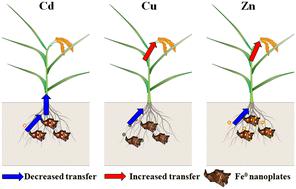当前位置:
X-MOL 学术
›
Environ. Sci.: Nano
›
论文详情
Our official English website, www.x-mol.net, welcomes your feedback! (Note: you will need to create a separate account there.)
Differential blocking effects of Fe0 nanoplates on rice accumulation of typical essential and non-essential heavy metal elements in paddy fields
Environmental Science: Nano ( IF 5.8 ) Pub Date : 2024-06-21 , DOI: 10.1039/d4en00258j Saiyong Zhu 1, 2 , Minjie Chen 2 , Huiwang Dai 1, 2 , Saiqa Menhas 1, 2 , Jiang Xu 2 , Daohui Lin 1, 2
Environmental Science: Nano ( IF 5.8 ) Pub Date : 2024-06-21 , DOI: 10.1039/d4en00258j Saiyong Zhu 1, 2 , Minjie Chen 2 , Huiwang Dai 1, 2 , Saiqa Menhas 1, 2 , Jiang Xu 2 , Daohui Lin 1, 2
Affiliation

|
This study investigated how nanoscale zero-valent iron (nZVI) affects the transfer of essential and non-essential heavy metals (HMs) from soil to rice in two paddy fields with varying Cd, Cu, and Zn pollution levels. Rice plants were cultivated with conventional field managements. 100 mg kg−1 Fe0 nanoplates were injected in rhizosphere soil at pre-sowing (P0), tillering (T1), jointing (J2), flowering (F3), and grain-filling (GF4) stages, respectively. Among them, the GF4 treatment performed the best, decreasing rice grain contents of Cd, Cu, and Zn (by 66.4%, 20.0%, and 24.8%, respectively) to the required safe levels. This reduction was attributed to significant inhibitions (25.9–49.4% for Cd, 52.4–61.2% for Cu, and 30.0–47.8% for Zn) in the soil-to-root transfers of these metals. Interestingly, essential and non-essential HMs exhibited different transfer patterns under the GF4 treatment. The root-to-stem transfer of Cd was also significantly inhibited (by 29.3–39.8%, p < 0.05) and its stem-to-grain transfer remained largely unchanged (p > 0.05) under the GF4 treatment, while the root-to-stem transfers of Cu and Zn kept relatively constant (p > 0.05) and their stem-to-grain transfers all increased (by 22.0–173.3%, p < 0.05), which fortified the essential trace elements in grain, causing the better performance of Fe0 nanoplates in Cd blocking. Additionally, the immobilization of soil HMs by Fe0 nanoplates persisted for approximately 60 days, contributing to the sustained efficacy of the GF4 treatment. These findings highlight the potential of nZVI, particularly applied at the grain-filling stage, to effectively mitigate HM accumulation in rice grains and improve crop safety in polluted environments.
中文翻译:

Fe0纳米片对稻田典型必需和非必需重金属元素积累的差异阻断作用
本研究调查了纳米级零价铁 (nZVI) 如何影响镉、铜和锌污染水平不同的两片稻田中必需和非必需重金属 (HM) 从土壤到水稻的转移。水稻采用常规田间管理进行栽培。在播种前(P0)、分蘖(T1)、拔节(J2)、开花(F3)和籽粒时将 100 mg kg −1 Fe 0 纳米片注入根际土壤中。分别是填充(GF4)阶段。其中,GF4处理效果最好,将水稻籽粒中Cd、Cu、Zn含量分别降低了66.4%、20.0%、24.8%,达到了规定的安全水平。这种减少归因于这些金属从土壤到根系转移的显着抑制(镉为 25.9-49.4%,铜为 52.4-61.2%,锌为 30.0-47.8%)。有趣的是,必需和非必需 HM 在 GF4 处理下表现出不同的转移模式。在 GF4 处理下,Cd 的从根到茎的转移也受到显着抑制(抑制率为 29.3-39.8%,p < 0.05),而茎到籽粒的转移在 GF4 处理下基本保持不变(p > 0.05)。 - Cu和Zn的茎转移保持相对恒定(p > 0.05),并且它们的茎到籽粒的转移均增加(22.0–173.3%,p < 0.05),强化了籽粒中必需的微量元素,导致更好的性能Fe 0 纳米片在 Cd 阻挡中的应用。此外,Fe 0 纳米板对土壤重金属的固定持续了大约 60 天,有助于 GF4 处理的持续功效。这些发现凸显了 nZVI 的潜力,特别是在籽粒灌浆阶段的应用,可有效减轻稻米中重金属的积累并提高污染环境中的作物安全。
更新日期:2024-06-21
中文翻译:

Fe0纳米片对稻田典型必需和非必需重金属元素积累的差异阻断作用
本研究调查了纳米级零价铁 (nZVI) 如何影响镉、铜和锌污染水平不同的两片稻田中必需和非必需重金属 (HM) 从土壤到水稻的转移。水稻采用常规田间管理进行栽培。在播种前(P0)、分蘖(T1)、拔节(J2)、开花(F3)和籽粒时将 100 mg kg −1 Fe 0 纳米片注入根际土壤中。分别是填充(GF4)阶段。其中,GF4处理效果最好,将水稻籽粒中Cd、Cu、Zn含量分别降低了66.4%、20.0%、24.8%,达到了规定的安全水平。这种减少归因于这些金属从土壤到根系转移的显着抑制(镉为 25.9-49.4%,铜为 52.4-61.2%,锌为 30.0-47.8%)。有趣的是,必需和非必需 HM 在 GF4 处理下表现出不同的转移模式。在 GF4 处理下,Cd 的从根到茎的转移也受到显着抑制(抑制率为 29.3-39.8%,p < 0.05),而茎到籽粒的转移在 GF4 处理下基本保持不变(p > 0.05)。 - Cu和Zn的茎转移保持相对恒定(p > 0.05),并且它们的茎到籽粒的转移均增加(22.0–173.3%,p < 0.05),强化了籽粒中必需的微量元素,导致更好的性能Fe 0 纳米片在 Cd 阻挡中的应用。此外,Fe 0 纳米板对土壤重金属的固定持续了大约 60 天,有助于 GF4 处理的持续功效。这些发现凸显了 nZVI 的潜力,特别是在籽粒灌浆阶段的应用,可有效减轻稻米中重金属的积累并提高污染环境中的作物安全。











































 京公网安备 11010802027423号
京公网安备 11010802027423号